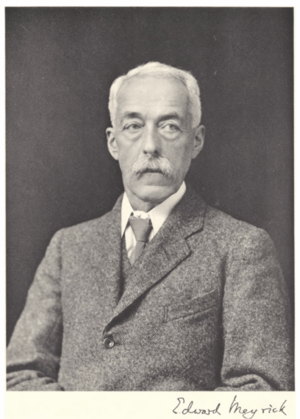Edward Meyrick facts for kids
Quick facts for kids
Edward Meyrick
|
|
|---|---|
 |
|
| Born | 25 November 1854 Thornhanger, Marlborough
|
| Died | 31 March 1938 (aged 83) Ramsbury, Wiltshire
|
| Citizenship | British |
| Alma mater | Trinity College, Cambridge |
| Known for | Handbook of British Lepidoptera (1895) |
| Scientific career | |
| Fields | Lepidopterology |
| Author abbrev. (zoology) | Meyrick |
Edward Meyrick (born November 25, 1854, in Ramsbury; died March 31, 1938, in Marlborough) was an English school teacher. He was also a very keen amateur entomologist, which means he studied insects. Edward Meyrick became a top expert on tiny moths, called microlepidoptera. Many people think he helped start the modern way we classify and understand these small insects.
Contents
Who Was Edward Meyrick?
Edward Meyrick came from a family of church leaders in Wales. He was born in Ramsbury, a town by the River Kennet. He went to school at Marlborough College and then studied at Trinity College, Cambridge.
A Passion for Moths
Even when he was a student, Edward loved studying moths. One friend said in 1872 that Meyrick "has not left a lamp, a paling, or a tree unexamined in which a moth could possibly, at any stage of its existence, lie hid." This shows how dedicated he was to finding and learning about moths!
He started writing about tiny moths in 1875. In December 1877, he got a teaching job at The King's School, Parramatta in New South Wales, Australia. This gave him even more chances to study insects.
Time in Australia
Edward Meyrick lived in Australia for ten years, from 1877 to 1886. He taught at Sydney Grammar School. During this time, he explored and studied many new insect species.
After his time in Australia, he returned to England. He went back to teach classics (ancient Greek and Roman studies) at Marlborough College. He also became a special member of the Linnean Society of New South Wales, a group for scientists.
Edward Meyrick's Important Books
Edward Meyrick wrote several important books about moths.
- Handbook of British Lepidoptera (1895): This book was about the moths and butterflies found in Britain.
- Exotic Microlepidoptera (1912–1937): This was a huge project! It included four full books and part of a fifth. It described tiny moths from all over the world.
He also wrote many shorter scientific papers.
His Contributions to Science
Edward Meyrick was a member of important scientific groups. He was a fellow of the Royal Entomological Society of London, which is for insect scientists. He was also a fellow of the Royal Society, a very old and respected scientific group in Britain.
Describing New Species
During his life, Edward Meyrick may have described more than 20,000 different kinds of moths and butterflies! This is an amazing number.
A Huge Collection
He collected over 100,000 insect specimens. This huge collection is now kept at the Natural History Museum, London. Many people believe he collected more specimens than anyone else.
Encouraging Others
Edward Meyrick wanted other people, especially amateur scientists, to study nature. In an article from 1898 called "Scientific Work in Local Societies," he gave ideas for research that members of local nature clubs could do.
His studies of moths and butterflies in Australia and New Zealand led him to suggest that these two landmasses were not connected in the past. He also developed ideas about how moths and butterflies evolved over time.
Later Life
Edward Meyrick was a lifelong member of the Conservative political party. He spent twelve years as the president of a local political group called the East Wilts Unionist Association.
Edward Meyrick passed away after a short illness. He is buried in the churchyard at Ramsbury, Wiltshire.

